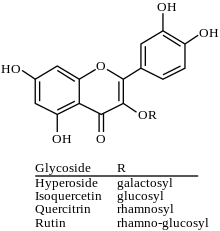Quercetin is a plant flavonol from the flavonoid group of polyphenols. It is found in many fruits, vegetables, leaves, seeds, and grains; capers, red onions, and kale are common foods containing appreciable amounts of it.[2][3] It has a bitter flavor and is used as an ingredient in dietary supplements, beverages, and foods.
 | |
 | |
| Names | |
|---|---|
| Pronunciation | /ˈkwɜːrsɪtɪn/ |
| IUPAC name 3,3′,4′,5,7-Pentahydroxyflavone | |
| Systematic IUPAC name 2-(3,4-Dihydroxyphenyl)-3,5,7-trihydroxy-4H-1-benzopyran-4-one | |
| Other names 5,7,3′,4′-flavon-3-ol, Sophoretin, Meletin, Quercetine, Xanthaurine, Quercetol, Quercitin, Quertine, Flavin meletin | |
| Identifiers | |
3D model (JSmol) | |
| 317313 | |
| ChEBI | |
| ChEMBL | |
| ChemSpider | |
| DrugBank | |
| ECHA InfoCard | 100.003.807 |
| EC Number |
|
| 579210 | |
| KEGG | |
PubChem CID | |
| UNII |
|
| UN number | 2811 |
CompTox Dashboard (EPA) | |
| |
| |
| Properties | |
| C15H10O7 | |
| Molar mass | 302.236 g/mol |
| Appearance | yellow crystalline powder[1] |
| Density | 1.799 g/cm3 |
| Melting point | 316 °C (601 °F; 589 K) |
| Practically insoluble in water; soluble in aqueous alkaline solutions[1] | |
Except where otherwise noted, data are given for materials in their standard state (at 25 °C [77 °F], 100 kPa). | |

Occurrence
Quercetin is a flavonoid widely distributed in nature.[2] The name has been used since 1857, and is derived from quercetum (oak forest), after the oak genus Quercus.[4][5] It is a naturally occurring polar auxin transport inhibitor.[6]
Quercetin is one of the most abundant dietary flavonoids,[2][3] with an average daily consumption of 25–50 mg.[7]
| Foods | Quercetin, mg / 100 g |
|---|---|
| capers, raw | 234[3] |
| capers, canned | 173[3] |
| lovage leaves, raw | 170[3] |
| dock like sorrel | 86[3] |
| radish leaves | 70[3] |
| carob fiber | 58[3] |
| dill weed, fresh | 55[3] |
| coriander | 53[3] |
| yellow wax pepper, raw | 51[3] |
| fennel leaves | 49[3] |
| onion, red | 32[3] |
| radicchio | 32[3] |
| watercress | 30[3] |
| kale | 23[3] |
| chokeberry | 19[3] |
| bog blueberry | 18[3] |
| buckwheat seeds | 15[3] |
| cranberry | 15[3] |
| lingonberry | 13[3] |
| plums, black | 12[3] |
In red onions, higher concentrations of quercetin occur in the outermost rings and in the part closest to the root, the latter being the part of the plant with the highest concentration.[8] One study found that organically grown tomatoes had 79% more quercetin than non-organically grown fruit.[9] Quercetin is present in various kinds of honey from different plant sources.[10]
Biosynthesis
In plants, phenylalanine is converted to 4-coumaroyl-CoA in a series of steps known as the general phenylpropanoid pathway using phenylalanine ammonia-lyase, cinnamate-4-hydroxylase, and 4-coumaroyl-CoA-ligase.[11] One molecule of 4-coumaroyl-CoA is added to three molecules of malonyl-CoA to form tetrahydroxychalcone using 7,2′-dihydroxy-4′-methoxyisoflavanol synthase. Tetrahydroxychalcone is then converted into naringenin using chalcone isomerase.
Naringenin is converted into eriodictyol using flavanoid 3′-hydroxylase. Eriodictyol is then converted into dihydroquercetin with flavanone 3-hydroxylase, which is then converted into quercetin using flavonol synthase.[11]
Glycosides

Quercetin is the aglycone form of a number of other flavonoid glycosides, such as rutin (also known as quercetin-3-O-rutinoside) and quercitrin, found in citrus fruit, buckwheat, and onions.[2] Quercetin forms the glycosides quercitrin and rutin together with rhamnose and rutinose, respectively. Likewise guaijaverin is the 3-O-arabinoside, hyperoside is the 3-O-galactoside, isoquercitin is the 3-O-glucoside and spiraeoside is the 4′-O-glucoside. CTN-986 is a quercetin derivative found in cottonseeds and cottonseed oil. Miquelianin is the quercetin 3-O-β-D-glucuronopyranoside.[12]
Several taxifolin (also known as dihydroquercetin) glycosides also exist. Isoquercetin is the 3-O-glucoside of quercetin.
Rutin degradation pathway
The enzyme quercitrinase can be found in Aspergillus flavus.[13] This enzyme hydrolyzes the glycoside quercitrin to release quercetin and L-rhamnose. It is an enzyme in the rutin catabolic pathway.[14]
Pharmacology
Pharmacokinetics
The bioavailability of quercetin in humans after oral intake is very low, with one study concluding it must be less than 1%.[15] Intravenous injection of quercetin shows a rapid decay in concentration described by a two-compartment model (initial half-life of 8.8 minutes, terminal half-life of 2.4 hours).[15] Because it undergoes rapid and extensive metabolism, the biological effects presumed from in vitro studies are unlikely to apply in vivo.[2][16][17][18] Quercetin supplements in the aglycone form are less bioavailable than the quercetin glycoside often found in foods, especially red onions.[2][19] Ingestion with high-fat foods may increase bioavailability compared to ingestion with low-fat foods,[19] and carbohydrate-rich foods may increase absorption of quercetin by stimulating gastrointestinal motility and colonic fermentation.[2] Whereas quercetin has been shown to be a potent anti-inflammatory compound in a variety of in vitro and in vivo bioassay models, oral quercetin in human subjects has not exhibited the desired effects.[20] Because of low solubility and poor bioavailability of quercetin, derivatives have been synthesized to overcome these challenges and enhance its biological activity, leading to compounds with improved properties for possible therapeutic applications.[21]
Metabolism
Quercetin is rapidly metabolized (via glucuronidation) after the ingestion of quercetin foods or supplements.[22] Five metabolites (quercetin glucuronides) have been found in human plasma after quercetin ingestion.[23][22] Taken together, the quercetin glucuronides have a half-life around 11–12 hours.[22]
In rats, quercetin did not undergo any significant phase I metabolism.[24] In contrast, quercetin did undergo extensive phase II (conjugation) to produce metabolites that are more polar than the parent substance, hence are more rapidly excreted from the body. In vitro, the meta-hydroxyl group of catechol is methylated by catechol-O-methyltransferase. Four of the five hydroxyl groups of quercetin are glucuronidated by UDP-glucuronosyltransferase. The exception is the 5-hydroxyl group of the flavonoid ring, which generally does not undergo glucuronidation. The major metabolites of orally absorbed quercetin are quercetin-3-glucuronide, 3'-methylquercetin-3-glucuronide, and quercetin-3'-sulfate.[24] A methyl metabolite of quercetin has been shown in vitro to be more effective than quercetin at inhibiting lipopolysaccharide-activated macrophages.[18]
Compared to other flavonoids, quercetin is one of the most effective inducers of the phase II detoxification enzymes.[25]
In vitro studies show that quercetin is a strong inhibitor of the cytochrome P450 enzymes CYP3A4 and CYP2C19 and a moderate inhibitor of CYP2D6.[26][27] Drugs that are metabolized by these pathways may have increased effect. An in vivo study found that quercetin supplementation slows the metabolism of caffeine to a statistically significant extent in a particular genetic subpopulation, but in absolute terms the effect was almost negligible.[28]
Food safety
In 2010, the U. S. Food and Drug Administration acknowledged high-purity quercetin as generally recognized as safe for use as an ingredient in various specified food categories at levels up to 500 mg per serving.[29]
Health claims
Quercetin has been studied in basic research and small clinical trials.[2][30][31][32] While supplements have been promoted for the treatment of cancer and various other diseases,[2][33] there is no high-quality evidence that quercetin (via supplements or in food) is useful to treat cancer[34] or any other disease.[2][35]
The US Food and Drug Administration has issued warning letters to several manufacturers advertising on their product labels and websites that quercetin product(s) can be used to treat diseases.[36][37] The FDA regards such quercetin advertising and products as unapproved – with unauthorized health claims concerning the anti-disease products – as defined by "sections 201(g)(1)(B) and/or 201 (g)(1)(C) of the Act [21 U.S.C. § 321(g)(1)(B) and/or 21 U.S.C. § 321(g)(1)(C)] because they are intended for use in the diagnosis, cure, mitigation, treatment, or prevention of disease",[36][37] conditions not met by the manufacturers.
Safety
Little research has been conducted into the safety of quercetin supplementation in humans, and the results are insufficient to give confidence that the practice is safe. In particular, a lack of safety information exists on the effect of quercetin supplementation for pregnant women, breastfeeding women, children, and adolescents. The hormonal effects of quercetin found in animal studies raise the suspicion of a parallel effect in humans, particularly in respect of estrogen-dependent tumors.[38]
Quercetin supplementation can interfere with the effects of medications. The precise nature of this interaction is known for some common medicines, but for many, it is not.[38]
See also
References
External links
 Media related to Quercetin at Wikimedia Commons
Media related to Quercetin at Wikimedia Commons
